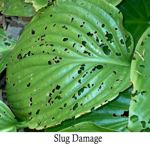|
|
 Hostas
as a species, tend to have only a few serious problems.
In comparison to many other herbaceous perennials, they
tend to be what people call "problem free" plants.
However, they do have a few disease, insect and
physiological problems that can be problematic to the
home gardener. Hostas
as a species, tend to have only a few serious problems.
In comparison to many other herbaceous perennials, they
tend to be what people call "problem free" plants.
However, they do have a few disease, insect and
physiological problems that can be problematic to the
home gardener.
We have listed several of these problems below and have
added information to our database on them. Hostaphiles
will notice the absence of a few serious problems
including deer, foliar nematodes and hosta virus X. So
far, we have not been able to gather good data on these
problems which lends itself to inclusion in a database.
We will continue to be on the lookout for such
information from reliable sources.
|
 |
 |
A few hostas
tend to emerge from the ground very early in
the spring. In Northern gardens, heavy
frosts may still occur after the leaves are
out of the ground. The result is frost
damage that will show as tears in the
leaves. To prevent this, you may need to
cover these plants on spring nights when
heavy frost is predicted. |
|
|
 |
|
 |
 |
Certain
cultivars with blue/green foliage and either
marginal or medial (center) variegation have
a leaf problem. In the late spring, the
variegated part of the leaf begins to dry
out and turn a brownish color. Our lists
show those known to suffer this defect and
others of similar types of hostas that do
not. |
|
|
 |
|
 |
 |
Slugs are one
of the major pests of hostas. They chew
holes of various sizes in the leaves and
cause the plants to look unsightly by the
end of the season. In various references,
certain hostas are listed as either being
very susceptible to slug damage. i.e. slug
bait or resistant to their damage often due
to thick leaf tissue. |
|
|
 |
 |
 |
A few hostas
develop a leaf problem called the drawstring
effect. The edge of the leaf seems to shrink
and form a cupping effect as the season
progresses. Cupping can be a desirable
effect, however, in plants that exhibit the
drawstring effect, the edges of the leaves
tend to split and pull apart as the season
progresses. This results in a ragged,
unsightly appearance to the plant. |
|
|
 |
|
 |
|
| |
|



